
SS Cleveland was a German transatlantic ocean liner that was launched in 1908 and scrapped in 1933. Cleveland was built for the Hamburg America Line (HAPAG) as a sister ship for Cincinnati.
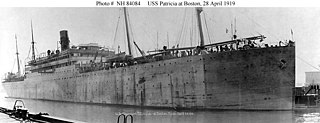
USS Patricia was a transatlantic liner that was launched in Germany in 1899 and spent most of her career with Hamburg America Line (HAPAG). She was the last to be built of a class of four HAPAG sister ships that came from shipyards in the United Kingdom and Germany between 1896 and 1899.
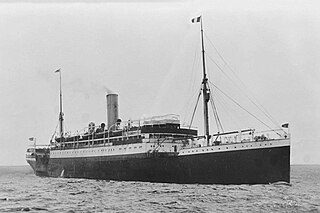
SS Fürst Bismarck was a Hamburg America Line (HAPAG) ocean liner. She was launched in Scotland in 1905. In 1914 she was renamed Friedrichsruh. In 1919 the United Kingdom seized her as World War I reparations. In 1921 Messageries Maritimes acquired her and renamed her Amboise. She was scrapped in Italy in 1935.
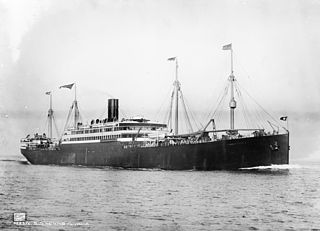
SS Pennsylvania was a transatlantic liner that was launched in Ireland in 1896 and spent most of her career with Hamburg America Line (HAPAG). She was the first of a class of four HAPAG sister ships that were built in the United Kingdom and Germany between 1896 and 1899.

USS Covington (ID-1409) was a German transatlantic ocean liner that was launched in 1908 for the Hamburg America Line (HAPAG) as Cincinnati. In 1917 the United States seized her, had her converted into a troop ship and renamed her Covington. In 1918 SM U-86 torpedoed her, killing six of her complement. Three tugs towed her about 1/3 the way to Brest, but she sank the afternoon of 2 July 1918.

USS Shoshone (ID-1760) was a German-built cargo liner that the United States Navy chartered during the First World War. She was launched in 1911 for the Hamburg America Line (HAPAG) as Wasgenwald. The Kerr Steamship Company bought her in 1917 and renamed her Shoshone. In 1919 she spent six months in the United States Navy, in which she made two round trips to and from France to repatriate US troops.

SS Ypiranga was a cargo liner that was launched in Germany in 1908 for the Hamburg America Line (HAPAG). In 1919 the United Kingdom seized her for World War I reparations. In 1921 Anchor Line acquired her and renamed her Assyria. In 1929 the Companhia Colonial de Navegação (CCN) bought her and renamed her Colonial. In 1950 she was sold for scrap, but she sank off the coast of Scotland while being towed to a scrapyard.
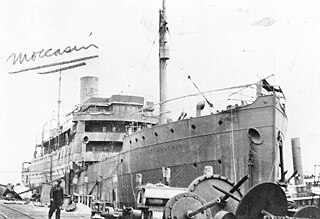
USS Moccasin (ID-1322) was a cargo liner that was launched in Germany in 1903 as Prinz Joachim. The US seized her in 1917. In 1918–19 she was renamed Moccasin and briefly served in the United States Navy. In 1920 she was returned to US merchant service and renamed Porto Rico. She was scrapped in 1933 or 1934.

USS General W. C. Gorgas (ID-1365) was a cargo liner that was launched in Germany in 1902 as Prinz Sigismund for the Hamburg America Line. In 1917 the USA seized her and renamed her General W. C. Gorgas. In 1945 she was transferred to the Soviet Union, which renamed her Mikhail Lomonosov. She was scrapped in March 1958.

USS General G. W. Goethals (ID-1443) was a German cargo liner that the United States seized during the First World War. She was launched in 1911 for the Hamburg America Line (HAPAG) as Grunewald. In 1917 the US seized her in Panama, and the Panama Canal Railway (PCR) operated her for the United States Shipping Board (USSB). In 1919 she spent six months in the United States Navy, in which she made three round trips to and from France to repatriate US troops. In 1920 the PRC bought her from the USSB. In 1925 the Black Star Line owned her. In 1926 the Munson Steamship Line bought her and renamed her Munorleans. She was scrapped in Scotland in 1937.

SS Pisa was a cargo and passenger steamship that was built in Scotland in 1896. She was in German ownership until 1917, when the United States seized her and renamed her Ascutney.

Kronprinzessin Cecilie was a Hamburg America Line (HAPAG) ocean liner. She was launched in Schleswig-Holstein in 1905. Her scheduled route was between Hamburg and Mexico.

The first RMS Saxonia was a passenger ship of the British Cunard Line. Between 1900 and 1925, Saxonia operated on North Atlantic and Mediterranean passenger routes, and she saw military service during World War I (1914–1918).

USS Arcadia (ID-1605) was a transatlantic liner that was launched in Ireland in 1896 and spent most of her career with Hamburg America Line (HAPAG). She was one of a series of at least five HAPAG sister ships that were built in the United Kingdom in 1896 and 1897.

SS Otsego was a cargo liner that was launched in Germany in 1901 as Prinz Eitel Friedrich. The USA seized her in 1917 and renamed her Otsego. In 1919 she served in the United States Navy as USS Otsego (ID-1628). She spent the 1920s and 30s in merchant service as Otsego. In 1941 she became the United States Army ship USAT Otsego. In 1945 she was transferred to the Soviet Union, which renamed her Ural. In 1947 she may have been renamed Dolinsk. She was either hulked or scrapped in 1955.

SS Bulgaria was a passenger-cargo steamship built in 1898 for the Hamburg American Line ("Hapag"). During World War I, she operated as a United States Army animal and cargo ship under the names USAT Hercules and USAT Philippines, and after the war was converted into the troop transport USS Philippines (ID-1677).
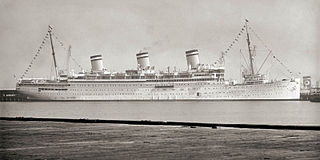
SS Reliance was one of a pair of transatlantic steam ocean liners that were launched in 1914 in Germany for the Hamburg America Line (HAPAG), sold to a Dutch shipping line in 1916, and seized by the United States as World War I reparations in 1922. United American Lines (UAL) operated her until 1926, when HAPAG bought her back.
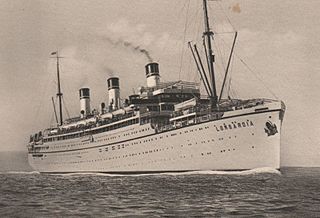
SS Lombardia was one of a pair of transatlantic steam ocean liners that were launched in 1914 in Germany for the Hamburg America Line (HAPAG), sold to a Dutch shipping line in 1916, and seized by the United States as World War I reparations in 1922. United American Lines (UAL) operated her until 1926, when HAPAG bought her back.
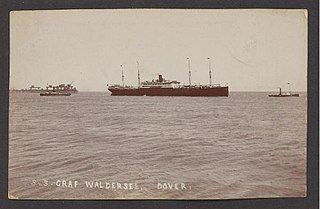
SS Graf Waldersee was a transatlantic liner that was launched in Germany in 1898 and spent most of her career with Hamburg America Line (HAPAG). She was the third of a class of four HAPAG sister ships that were built in the United Kingdom and Germany between 1896 and 1899.
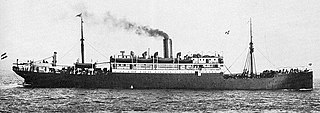
SS Prinz Oskar was a twin-screw cargo liner that was launched in Germany in 1902 for Hamburg America Line (HAPAG). She served various transatlantic routes between Europe and the Americas until the First World War began.






















